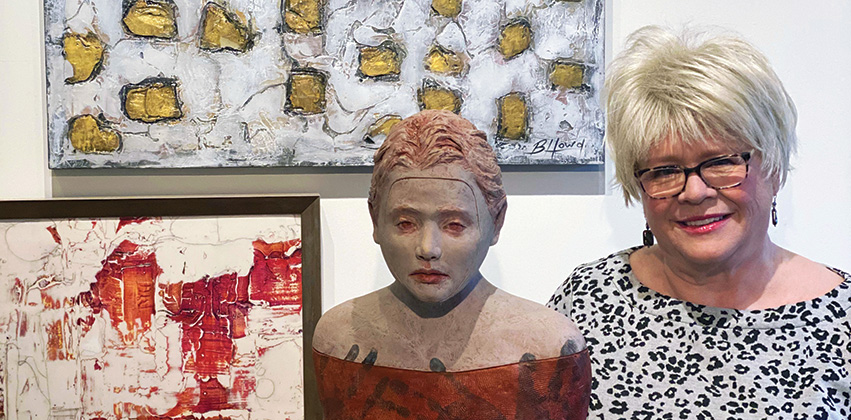
“What do you want to be when you grow up?” It seems like such an innocuous question, but it comes loaded with expectations. The things our culture encourages us to do—or discourages us to do—quietly shape our lives, pushing and pulling us on a daily basis. For many, it is expected that we find our path in life when we are young… and stick to it.
Painter and sculptor Billie Howd, however, wants nothing to do with that expectation. Now in her sixties, Howd is growing into an arts career driven by her passion to create, communicate, and urge positive change in society. “I am really grateful to have a passion—I think a lot of people don’t,” she observes. “And at my age, I can do what I want. Because ultimately the art I make is for me.”
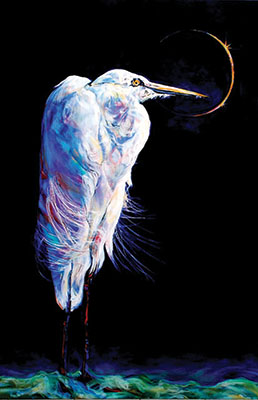
Trajectory in the Arts
Howd’s introduction to the arts came in the form of performance. “My first love was music,” she recalls. “I actually played viola with the Peoria Symphony Orchestra… just briefly!”
Music had a dramatic impact on her worldview even as a child. She recalls receiving Peter, Paul and Mary’s self-titled album from an uncle who lived in Berkeley, California. “There were some protest songs on there and it taught me values that I hold to this day,” she reflects. “I’ve always cared about equal rights.”
From there, Howd’s trajectory in the arts was somewhat less traditional, though no less interesting. She took a job at a dental laboratory at a young age, and soon realized that she enjoyed work that required a high level of technical skill. “It was something I could do with my hands,” she explains. “I have always made things—and it continues to be something I just have to do.
“Naturally, my first sculptures were carving molars!” she adds, chuckling. Howd was adept at the task, fashioning the teeth to their perfect fit. She met her husband at the same laboratory, and they worked together for years before starting their own business, Howd Crown and Bridge Laboratory. For the next two decades, they created crowns, bridges, laminates, and other dental appliances out of their home.
“There’s a lot to it when you’re doing it by hand,” she notes. “You have to have a knowledge of casting.” Using a porcelain oven, she would fire tooth-colored porcelain over metal copings in order to fabricate teeth based on impressions sent from the dentist. Howd enjoyed this work, but coupled with raising children, it left little time for her to pursue other interests. Along the way, however, she managed to take a painting class. “It fired something up in me,” she recalls. “I knew I had a passion.”
By this time, Howd was in her forties—and the desire to paint burned strongly within. Seeking to hone her skills, she started taking classes with renowned Peoria-based artist Preston Jackson. “He was an extremely knowledgeable, wonderful and encouraging teacher,” she recalls.
Those classes catapulted her into 25 years of learning—and an apprenticeship with Jackson. “He taught me how to paint and sculpt,” Howd explains. “I was lucky enough to be able to work on some of his public art.” She observed him working with clients and assisted on sculptures like the African American Civil War Soldiers Monument in Jackson’s hometown of Decatur, Illinois.
During those years, Howd had limited time to dedicate to art due to her work schedule. “But when my schedule loosened up a bit, I was able to devote a little more time to it… and then a little more.” As she did, she found her creative energies continued to flow without fail.
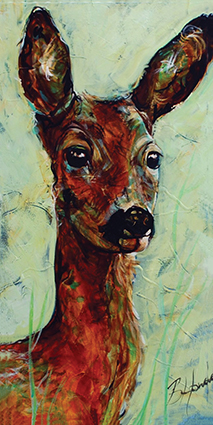
Worlds of Expression
Like many visual artists, Howd’s first paintings were figurative. Jere Allen, who is often called “the Mississippi Rembrandt,” was one of her primary influences. Hailed for his use of dramatic and electric colors, Allen’s work was on display at the Contemporary Art Center of Peoria when Howd first encountered it. She later took a workshop with him and was incredibly moved. “I felt like he painted the way I wanted to paint,” she recalls.
One can see Allen’s subtle influence in one of Howd’s more striking paintings, “Egret Under An Eclipse,” in which a white egret stands hunched beneath an eclipsing sun and a stark, black sky. If you look closely, a rainbow of colors has been incorporated into what is otherwise a fairly straightforward image. The inspiration for this piece came after Howd experienced the total solar eclipse in 2017. “I was struck by the beauty and the silence of it… I heard the whole world go quiet,” she reflects. “Sometimes nature has a way of just stopping you in your tracks.”
Her thoughts then turned from her own experience to that of the animal world. “I was thinking about how the whole world received this incredible natural phenomenon—and that all of the animals were also underneath this eclipse. We all were.”
Creatures like birds and deer are common in Howd’s figurative paintings—they bear almost human-like expressions as the artist attempts to convey the inner lives of her subjects. “Animals have an inner life, too,” she notes. By using something akin to a human reaction, she is able to evoke that inner life in a way that is recognizable and meaningful.
Her abstracts, meanwhile, are equally striking and emotive. “It’s a freeing experience—a little different than trying to really bear down and do a likeness of something,” Howd explains. That freedom affords her the opportunity to discover the painting as she goes, she notes, deciding whether to keep or reject the elements that arise in the process.
In many ways, she finds the process of creating abstracts a meditation of sorts. “The artist goes to a place that is very mindful. It’s just me, the materials, and how I’m feeling,” she muses. “If it’s interesting, if it’s beautiful… if it gives you an emotional feeling like calm or fear—all those things make you feel more alive.”
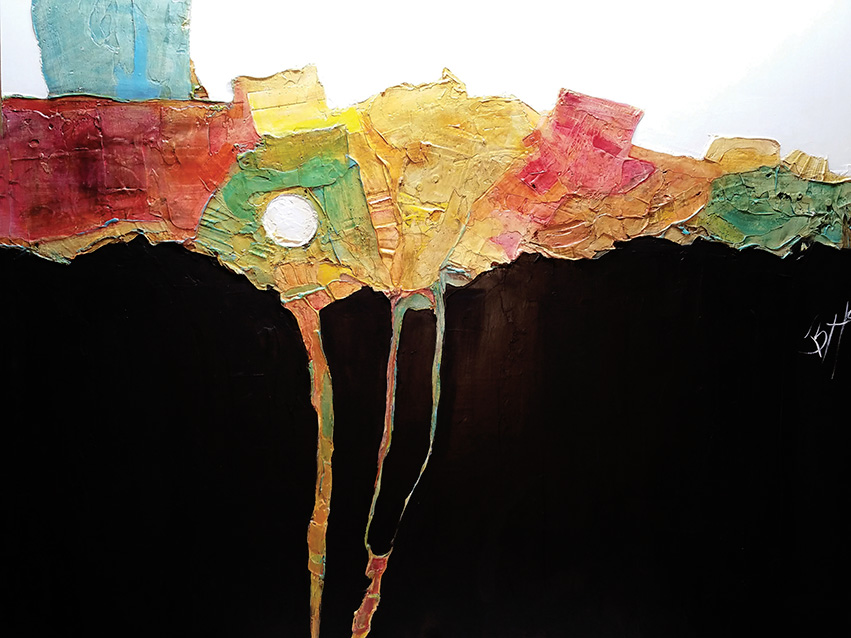
Projecting Her Voice
While it is fair to say that her paintings speak to the inner experience, Howd’s sculptures often suggest the ways in which these emotions intersect with the larger culture. Asked to contribute a sculpture for her first group show, she was tasked with creating a piece that expressed a view of personal and social importance. “I thought, well, that’s a nice challenge!” she recalls.
The resulting sculpture addressed the Equal Rights Amendment, which sought to guarantee all people equal protection under the law, regardless of sex or gender—a cause near and dear to her heart. Over the years, however, Howd watched as the proposed amendment faced many obstacles on its ultimately unsuccessful road to ratification. Reflecting on her frustrations, she sculpted the bust of a tired and deflated woman resting her head on a hand, her collar adorned with an ERA pin. Atop the woman’s head, a red bird tugs on a string of her knitted pink hat—recognizable from the 2017 Women’s March—signaling the ever-present threat of political unraveling. Despite setbacks, Howd continues to look forward with hope. “I really want to see women gain more strides in the next few years,” she suggests. “I hope I’m around to see it.”
With the advent of the #MeToo movement, Howd was compelled to create a sculpture that would express the inward and outward forces that women wrestle with on a daily basis. The resulting piece, which took first place in the “HOT CIAO VII” show at the Studios on Sheridan last fall, was subtly visceral in its message. “It has to do with women and the kind of difficulties they come into—as far as sexual harassment, quite frankly,” Howd explains. The sculpture depicts a bust of a woman shaped like a vessel, a quietly forlorn look upon her face.
“There are male handprints on that vessel,” she points out. “I rarely come across a woman that hasn’t had some sort of experience with sexual harassment. I was hoping that it expressed that point of view… that it’s been difficult, and how much I hope that we have much fewer incidences of it.”
Two lines encircle the sculpture—a line around the bust illustrates the disconnect women often experience with their bodies due to cultural expectations and traumatic events, while a line around the face signifies the mask women feel they must wear to appear that they are okay. “But inside she’s not,” Howd suggests. “She has baggage. Her face is a mask.”
From emotive portrayals of animal life to sculptures with poignant and timely messages, Howd’s artistic range is vast. “I have read that one should focus on one medium or style and really delve into it,” she notes. “I can see a lot of value in that… but I have never been able to do it.” In fact, she notes that she is far from finished exploring new artistic mediums.
“Truthfully, I feel like I’ve just started! I’ve done figurative painting, abstracts, and now I’m going off in another direction, because I just can’t help myself,” she chuckles. “I don't know how else to explain it. But I have a lot more to say.”
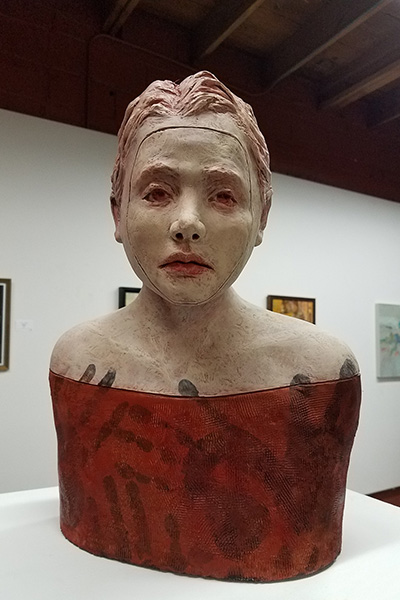
Never Too Late
Howd admits that she has not always been quite so vocal in her expression. “I’m one of those artists that are not really happy with the limelight,” she explains. But just as that Peter, Paul and Mary album impacted her so dramatically in her youth, she recognizes that all art has the power to do the same. “That’s what I am into right now—actually saying something. I realized I hadn’t done that enough, but it’s time to start… and it’s never too late!”
One of the ways she shares her voice and passion is by serving on the African American Hall of Fame’s Committee On Recognizing Achievements (CORA). The group is currently raising funds to cast two bronze sculptures of the late C.T. Vivian, the esteemed civil rights leader and former Peorian, based on her mentor Preston Jackson’s designs. Reflecting on this work, Howd expresses excitement at using the arts to honor individuals who have made such an impact on their community—and the world.
But if art is to bring about change, Howd notes it is essential for the artist to feel passionate about it—because without passion, it has no power. “It’s an amazing thing… how the passion you feel inside can translate to a work of art,” she says. “Almost like it’s a tangible thing! But if you’re not passionate about what you’re doing, then it’s not going to be there.”
Thankfully, Howd is not lacking in that essential element—and she plans to continue creating for many years to come. To others who would seek to follow her down that path, she offers words of inspiration. “I hope that I would encourage some older people who have always wanted to do some artwork just to start!” she explains. “You can start at any point—and at any age.” PM
- Log in to post comments

